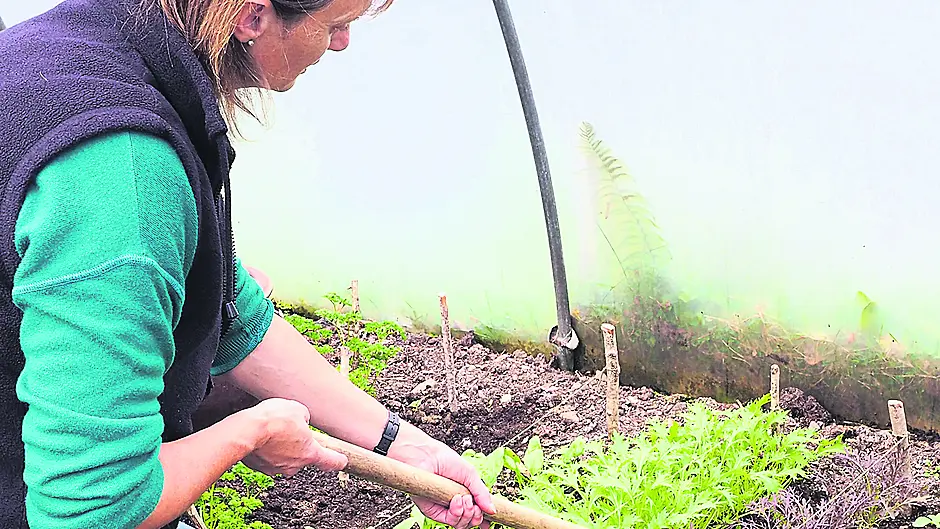By Joyce Russell
WINTER is almost with us and cold weather can make the idea of working outdoors less enticing. Do the things that need to be done, like digging drains to shed water away from garden beds, or clearing fallen debris after a storm. If you have a greenhouse, polytunnel, or conservatory, then this can be a time to appreciate the benefits of gardening under cover.
There is no great pressure, but it can be rewarding to get everything in good order and to make your greenhouse into a tidy and cared for environment.
Greenhouse soil health
You need to look after the soil if you want to keep growing healthy vegetables in a greenhouse or polytunnel. This isn’t just about digging in manure or compost, although this is good practice for empty beds, of course. You also need to do your best for the soil around growing plants and to pay a little extra attention to beds where tomato plants have been removed.
For rows of salad and winter greens: use a hoe, or your fingers, to break up any green film on the soil’s surface. You can clear this off entirely and loosen the soil with a small fork.
Try not to disturb the roots and don’t damage the stems of growing plants. Loosening the soil’s surface helps to reduce compaction, which helps with root growth, and creates a better environment for beneficial organisms.
Water sparingly in the winter months: the natural water level in the soil may be adequate or a quick water every week may do for low beds. Raised beds full of plants can drain well and will need more regular watering. Ensure adequate ventilation so moulds don’t get a chance to proliferate and keep rows weeded so roots don’t compete for nutrients.
Empty tomato beds: these need special care to ensure disease isn’t carried forward from one year to the next. Be extra diligent about clearing any fallen fruits and leaves after you remove the plants. Weed the surface and turn the soil over if you can. Fresh seaweed can work wonders as a soil cleanser if spread over the surface, or dug into a bed. You can also help reduce the spread of disease by leaving the soil to dry out through the winter (earthworms etc migrate to damper areas) – dry soil will need a good soaking in the spring, but disease spores are less likely to survive up to that point.
Check structures
Look around your greenhouse and check for broken glass or rips in polythene. It’s a good idea to mend any damage before the problem gets worse with the rattle and flap of winter winds.
You might be able to tape a small crack in a pane, but it’s better to replace the piece of glass altogether and make sure it is held firmly in place. Buy 10cm wide clear polytunnel repair tape for fixing polythene structures. This should be UV stabilised so it doesn’t deteriorate after a couple of sunny summers. Make sure surrounding polythene is clean and dry before mending rips. And don’t stint on tape – you may need horizontal bands as well as vertical ones for dealing with large rips.
Crab apples and berries
I have an eye on some small branches of golden crab apples and others with steadily ripening holly berries. These may disappear as bird food before I get around to the task, but I’m hoping to make a Christmas garland and decorations for the house. There are still lots of decorative branches, leaves, fir cones, and berries, if you look close enough. And what better way to appreciate the continuing bounty from your garden than by bringing some natural decorations into the house. Start collecting suitable materials now. A simple bunch in a vase can bring a lovely reminder of your garden as we head through the winter months.
Stored onions and garlic
Use your nose and have a good sniff as you pass the strings of onion and garlic hanging in a shed or in your kitchen. A distinctly bad smell is often the first way that you know that something has started to rot. It can be a single obvious bulb that needs to be removed, but look closer in case there is more than one.
Give any odd-looking bulbs a gentle squeeze. If they are soft, or ooze any liquid, then they should go out straight away. If one has a small soft spot it’s possible that the rest of the bulb may still be fit for use. If any bulb has started to drip smelly liquid then it should be dispatched to the bin straight away.
Don’t put rotten or mouldy onions or garlic onto the compost heap. Some disease spores are particularly persistent and they could spread through infected compost into next year’s crop.








